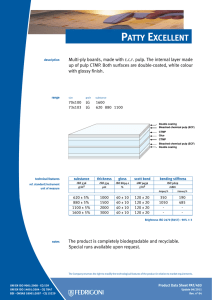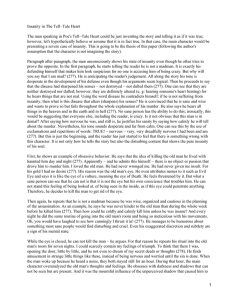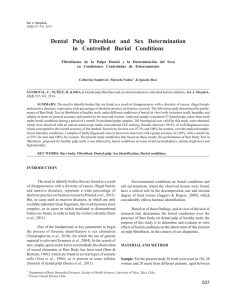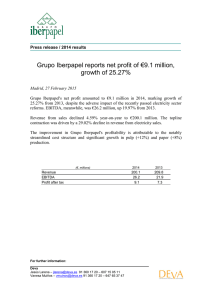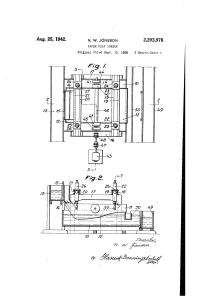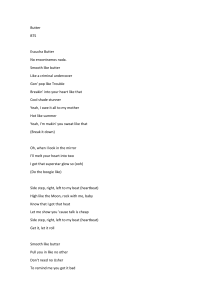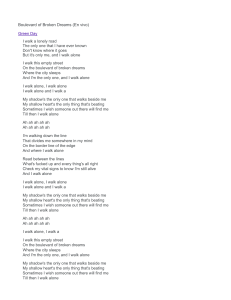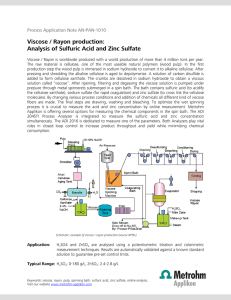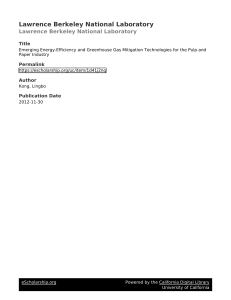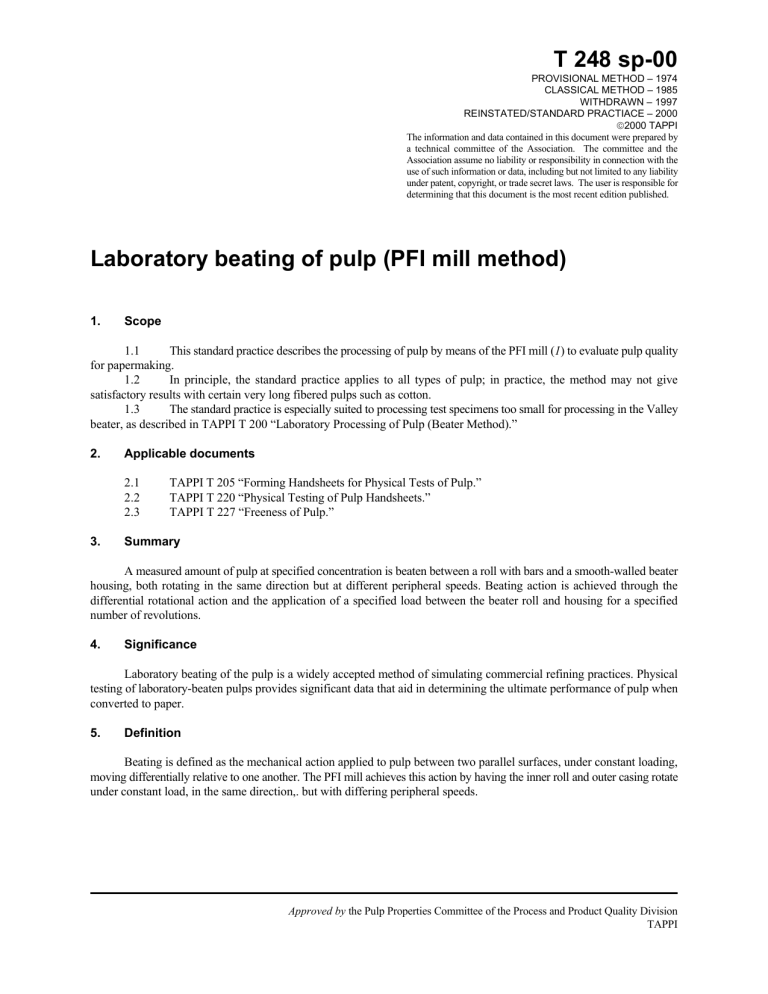
T 248 sp-00 PROVISIONAL METHOD – 1974 CLASSICAL METHOD – 1985 WITHDRAWN – 1997 REINSTATED/STANDARD PRACTIACE – 2000 2000 TAPPI The information and data contained in this document were prepared by a technical committee of the Association. The committee and the Association assume no liability or responsibility in connection with the use of such information or data, including but not limited to any liability under patent, copyright, or trade secret laws. The user is responsible for determining that this document is the most recent edition published. Laboratory beating of pulp (PFI mill method) 1. Scope 1.1 This standard practice describes the processing of pulp by means of the PFI mill (1) to evaluate pulp quality for papermaking. 1.2 In principle, the standard practice applies to all types of pulp; in practice, the method may not give satisfactory results with certain very long fibered pulps such as cotton. 1.3 The standard practice is especially suited to processing test specimens too small for processing in the Valley beater, as described in TAPPI T 200 “Laboratory Processing of Pulp (Beater Method).” 2. Applicable documents 2.1 2.2 2.3 3. TAPPI T 205 “Forming Handsheets for Physical Tests of Pulp.” TAPPI T 220 “Physical Testing of Pulp Handsheets.” TAPPI T 227 “Freeness of Pulp.” Summary A measured amount of pulp at specified concentration is beaten between a roll with bars and a smooth-walled beater housing, both rotating in the same direction but at different peripheral speeds. Beating action is achieved through the differential rotational action and the application of a specified load between the beater roll and housing for a specified number of revolutions. 4. Significance Laboratory beating of the pulp is a widely accepted method of simulating commercial refining practices. Physical testing of laboratory-beaten pulps provides significant data that aid in determining the ultimate performance of pulp when converted to paper. 5. Definition Beating is defined as the mechanical action applied to pulp between two parallel surfaces, under constant loading, moving differentially relative to one another. The PFI mill achieves this action by having the inner roll and outer casing rotate under constant load, in the same direction,. but with differing peripheral speeds. Approved by the Pulp Properties Committee of the Process and Product Quality Division TAPPI T 248 sp-00 6. Laboratory beating of pulp (PFI mill method) / 2 Apparatus PFI mill1 (see Figs. 1 and 2)2, consisting of the following: 6.1 1 Names of suppliers of testing equipment and materials for this method may be found on the Test Equipment Supplier's list in the bound set of TAPPI Test Methods, or may be available from the TAPPI Technical Operations Department. 2 Figures 1 and 2 are reproduced with permission of CPPA-Technical Section. 3 / Laboratory beating of pulp (PFI mill method) T 248 sp-00 6.1.1 A stainless steel roll with chiseled bars and a stainless steel bed plate in the form of a container with a smooth cylindrical internal wall, into which the pulp is charged. Both bedplate and roll rotate on independent vertical axes in the same direction, the roll rotating faster than the bedplate. NOTE 1: The first mills manufactured had beating elements made of bronze; however, the surfaces were conditioned to give the same results of beating as elements made of stainless steel . 6.1.2 The roll has 33 bars, each 50 mm (1.97 in.) long and 5 mm (0.2 in.) wide. The bars are spaced uniformly about the circumference of the roll and are parallel to the roll axis. The diameter of the roll, measured across the bars, is 200 mm (7.86 in.). Depth of the cavities between the bars is 30 mm (1.18 in.). The roll is driven by a 750-W (1.0-hp) motor. Rotation speed of the roll, unloaded, is 24.3 " 0.2 revolutions per second (1460 " 10 rpm). The number of revolutions of the roll is indicated by a counter. 6.1.3 The beater housing has an internal diameter of 250 mm (9.85 in.) and is driven by a 375-W (0.5-hp) motor. The prescribed difference in peripheral speed between the beating elements of 6.0 " 0.3 m/s with a roll speed of 24.3 r/s (1460 rpm), unloaded, requires that the housing speed be 11.8 " 0.2 revolutions per second (710 " rpm) (2). Both the roll and beater housing are driven by means of timing belts. The change in rotational speed of either element during beating is not to exceed 1.1 revolutions per second (66 rpm). 6.1.4 The beating pressure is obtained by means of a load applied by a lever that presses the roll against the wall of the beater housing. Pressure applied is to be 340 g/mm (19.0 lb./in.) of bar length, 17 kg (37.4 lb.) total bar pressure. NOTE 2: For very easily beaten pulps (e.g., hardwood sulfites) a smaller load, which gives a beating pressure of only 180 g/mm (10.05 lb./in.) of bar length, 9 kg (19.8 lb.) total bar pressure, may be applied, provided this is noted in the test report. 6.1.5 The mill is also equipped with a device which includes a Vernier adjusting screw regulating the distance between the roll and housing when grinding-in and conditioning the mill. The beating elements are made of stainless steel. 6.2 Disintegrator, as described in T 205. 7. Calibration and maintenance 7.1 Calibration 7.1.1 The PFI beater is a rugged machine requiring calibration only after major changes have occurred in the beater roll and/or housing. Pulp to be processed should be cleared of hard particles that may damage the roll surfaces and beater housing. If beating surfaces have been damaged so that the mill gives incorrect results for reference pulps, the beating surfaces must be ground and conditioned as follows. 7.1.2 Reverse the direction of rotation of the motor driving the beater housing. 7.1.3 Set the gap micrometer so that there is a gap of 0.5 mm between the beating elements (1 scale division equals 0.05 mm or 0.002 in.). 7.1.4 Charge the beater housing with 15.0 g of Carborundum powder No. 180 suspended in 50 mL soluble cutting oil diluted with 50 mL of water at 26 " 1EC. 7.1.5 Rotate the beater housing so that the powder suspension is flung against the housing. Ensure that the cover is in its position in the bracket and insert the roll in the bed plate or housing. Stop the housing and press the cover into position. Start both beating elements, apply the load and carefully reduce the gap between the elements with a micrometer screw until a grinding sound is heard. Run the mill until the sound has diminished significantly. Then reduce the gap further but not exceeding one-half scale division (0.03 mm or 0.001 in.). Continue grinding step by step in this manner until the damage is repaired. 7.1.6 Clean the beating elements and the cover with soap and water. Ensure that no Carborundum powder remains. 7.1.7 After this rough grinding, perform a fine grinding with Carborundum powder F or silicon carbide powder No. 280 as described in 7.1.4 and 7.1.5. 7.1.8 Clean the beater as outlined in 6.1.6. 7.1.9 Carefully, without rounding, remove with a fine file or fine flat Carborundum stone any rough edges that have appeared on the trailing edges of the bars. Clean and roll thoroughly to remove filings. 7.1.10 Restore the rotation of the beater housing to its normal direction. Set the distance between the roll and housing to 2 mm (0.079 in.) with a gap micrometer. Polish the beating surfaces by beating 30 g of bleached softwood kraft or bleached softwood sulfite to which 15 g of Carborundum powder F has been mixed. The degree of grinding may be T 248 sp-00 Laboratory beating of pulp (PFI mill method) / 4 checked by placing writing paper and carbon paper between the roll and housing, applying light pressure, and rotating the elements manually. 7.1.11 Upon completion of the conditioning cycle, clean the housing and roll thoroughly. Disengage the gap micrometer and set to zero clearance. 7.1.12 Stabilize the beating surfaces by making a series of normal pulp beatings totaling between 50,000 and 100,000 roll revolutions. Final evaluation of the degree of conditioning must be verified by beating a previously standardized pulp in accordance with Section 8. 7.2 Maintenance 7.2.1 The precision of the results depends to a great extent on the cleanliness of the apparatus. Remove rosin deposits as soon as they are observed. Wash with a filtered solution of sodium pyrophosphate or other resin dispersant at 70 to 80°C. 7.2.2 Timing belt drives are recommended to ensure correct speed levels of housing and beater roll. For beaters not so equipped, check that the belts are not slipping when pressure is applied (6.1.3). 7.2.3 Check that all parts move freely so that the entire applied load is transmitted as beating pressure. 7.2.4 Under normal conditions beating efficiency of the mill should remain constant. Preventive maintenance should be carried out every 10,000 beatings by stripping the machine and examining the bearings for wear, replacing them if necessary. Excessive vibration is caused by wear of the spur tooth sectors through which beating pressure is applied to the roll assembly. Replace worn sectors. 8. Sampling and test specimens From a sample of the pulp, obtain a specimen weighing 24.0 " 0.25 g o.d. basis for each run. When sampling dry lapped pulp, avoid cut edges and do not cut the pulp. With dried pulps, soak the specimen in 500 mL of distilled water at room temperature for a minimum of 4 h. Tear the soaked pulp in pieces approximately 25 H 25 mm (approximately 1 H 1 in.). It is essential that the pulp be thoroughly softened by soaking to ensure that preliminary disintegration results in the least possible beating effect. Wet pulps may be disintegrated without soaking. NOTE 3: 9. If a different sample weight is used, such as 30 g o.d., this should be reported with test results. Procedure 9.1 Disintegration 9.1.1 Transfer the wet pulp and water used for soaking to the disintegrator. Add distilled water at 20 " 5°C to give a total volume of 2000 " 25 mL; the consistency will then be 1.2%. Set the revolution counter to 3000 (30,000 revs = 10 minutes) for an initial consistency of 20% or more. For consistencies less than 20%, set revolution counter to 15000 (15,000 revs = 5 minutes). 9.1.2 Ensure that the pulp is completely disintegrated. Pulps difficult to disintegrate, such as unbleached sulfate, may require longer disintegration than that specified in 8.1.1. Report any departure from recommended procedures. 9.2 Thickening 9.2.1 After disintegration, drain the pulp suspension on a Büchner funnel using a coarse filter paper to approximately 20% consistency. To avoid loss of fines, refilter the filtrate through the fiber mat until clear. Weigh the thickened pad and determine the amount of distilled water at 23 " 2°C to dilute the pulp to a total mass of 240 " 0.5 g, corresponding to a 10% stock consistency. Peel the pulp from the filter and place in a 400-mL beaker and wash the filter paper with the distilled water measured out above. 9.3 Beating 9.3.1 Adjust the temperature of the PFI mill to 23 " 2°C (see Note 3) before charging and, if necessary, that of the pulp such that the mean temperature does not exceed 23 " 2°C during beating. NOTE 4: When necessary for reasons of climatic conditions, a temperature of 25 " 5°C may be used provided this is reported with the test results. 9.3.2 Make sure the Vernier adjusting screw is completely backed off so that no fixed minimum clearance is set between the roll and housing. Under this condition the pulp layer will support the full beating load throughout the beating process. CAUTION: Do not operate PFI mill without pulp in the container with the Vernier adjusting screw set to no fixed minimum distance. Severe damage to the roll and bed plate can result. 5 / Laboratory beating of pulp (PFI mill method) NOTE 5: T 248 sp-00 A beating gap of 0.2 mm may be used. If a different beating gap is used, it should be reported with test results. 9.3.3 Ensure that the beater is clean. Check that the beating conditions are as specified in 6.1.3 and 6.1.4. Transfer the 10% pulp suspension to the beater housing and distribute it as evenly as possible over the wall. See that no pulp remains on the bottom of the beater housing within an area corresponding to the cross section of the roll. 9.3.4 Insert the beater roll in the housing and press the cover into position. 9.3.5 Set the beater housing rotating so that the pulp is slung against the wall and then start the roll. When both elements have attained full speed, gradually apply the required beating pressure, over a 4-s interval (see 6.1.4). Simultaneously start the revolution counter. CAUTION: When beating for a higher number of revolutions, the temperature of the beating elements may increase. If necessary, cool the beating elements with water to bring the temperature within the specified range before next beating. NOTE 6: One unit on the counter equals 10 revolutions of the roll. 9.3.6 After the required number of revolutions of the roll, discontinue beating by removing pressure from the roll. Shut off the motors; center the roll. Lift the roll and housing cover. Transfer all pulp to a 2000-mL beaker or directly to the disintegrator pot (2000 mL). Rinse the beater with water and add to the cylinder. NOTE 7: After beating, clean the mill thoroughly with water and, if necessary, pitch solvent. 9.3.7 Dilute the stock with distilled water to 2000 " 25 mL and clear in the disintegrator for 10,000 revolutions. 9.3.8 The pulp is now ready for freeness determination in accordance with TAPPI T 227 “Freeness of Pulp,” and making and testing of handsheets in accordance with T 205 and T 220. NOTE 8: 10. PFI mills and other laboratory beaters may affect the curl of fibers more than refiners in mills. This may be a source for differences in physical properties between PFI mill and mill refined samples. Report Report test results as specified in the appropriate test method including the number of beating revolutions. 11. Precision 11.1 Repeatability. PFI mills which have been calibrated and maintained by the prescribed procedure should be capable of providing results within the limits (2.77 H standard deviation shown in Table 1). Data provided by PAPRICAN based on CPPA method C.7. PFI mill which used a 0.2 mm gap between the roll and bedplate for eastern unbleached kraft pulp; 18 replications with bronze tackle; 17 replications with stainless steel tackle. 11.2 Reproducibility. Reproducibility data for the PFI mill are not as yet available. T 248 sp-00 Table 1. Laboratory beating of pulp (PFI mill method) / 6 Repeatability of unbleached kraft pulp (limits are 2.77 H standard deviation) Revolutions Freeness, mL CSF Bulk, cm3/g Burst factor Tear factor Breaking length Bronze tackle 3,000 6,000 9,000 12,000 15,000 682 615 522 387 282 " " " " " 33 55 77 82 111 1.56 1.98 1.44 1.40 1.38 " 0.2 " 0.1 " 0.01 " 0.1 " 0.1 61.4 81.8 90.8 96.1 98.5 " 12.2 " 13.7 " 11.1 " 7.9 " 10.5 162 131 119 112 108 " 35.0 " 19.0 " 12.0 " 12.0 " 18.0 8,600 10,700 11,600 12,100 12,500 " " " " " 1700 1400 140 1200 1300 Stainless tackle 1,000 3,000 6,000 9,000 12,000 710 674 564 414 272 " " " " " 16 36 75 90 98 1.69 1.57 1.48 1.43 1.40 " " " " " 36.9 64.2 85.9 95.3 99.9 " 9.8 " 13.7 " 10.0 " 8.2 " 12.6 242 154 122 110 106 " 63.0 " 25.0 " 16.0 " 9.0 " 13.0 5,900 8,900 10,800 11,900 12,400 " " " " " 800 1900 1000 1100 1100 12. 0.1 0.1 0.1 0.1 0.1 Keywords Beater, Beating, Revolutions, Laboratory beating, Laboratory refining, PFI mill, Pulp 13. Additional information 13.1 Effective date of issue: April 13, 2000. 13.2 It is recommended that if a different process pulp is to be processed in the mill, e.g., sulfite followed by kraft, or if a different species of pulp, e.g., hemlock followed by pine, that a minimum of three charges be beaten to 15,000 revolutions each prior to beating a sample for physical testing. 13.3 A normal beater evaluation with the PFI mill should consist of a zero beating time point and at least four points to approximately 300 mL CSF. 13.3.1 To establish the beating rate for a pulp specimen, one or two preliminary runs should be made determining the freeness/revolutions relationship. 13.3.2 The following beating schedules have been used to reduce specimens to 300-400 mL CSF: softwood kraft pulp, 10,000 revolutions with points at 0, 2500, 5000, 7500, and 10,000 revolutions; hardwood kraft pulp, 5,000 revolutions. 13.4 It is recommended that the standard pulp bale be acquired and used to make periodic checks on the performance of the beater. A statistical control chart (3) can be drafted to display the current performance of the beater. 13.5 Related methods: Scandinavian, SCAN C24; Canadian, CPPA C.7, PPRIC PB-6; Australian APPITA P209; International Organization for Standardization, ISO 5264:2. Literature cited 1. 2. 3. Stephansen, E., “Beating of Cellulose,” Norsk Skog. 2:207 (1948) (in English). Nomogram by W. H. Lawford in Hughes, F. T., “The Laboratory Processing of Pulp in Small Beaters,” Technical Paper T 391-5, Pulp and Paper Mag. Can. 69 (21): 86 (Nov. 1, 1968). Davies, O.L., “Statistical Methods in Research and Production,” Hafner Publishing Co., New York, New York, 1961. Your comments and suggestions on this procedure are earnestly requested and should be sent to the TAPPI Technical Operations Manager. •

